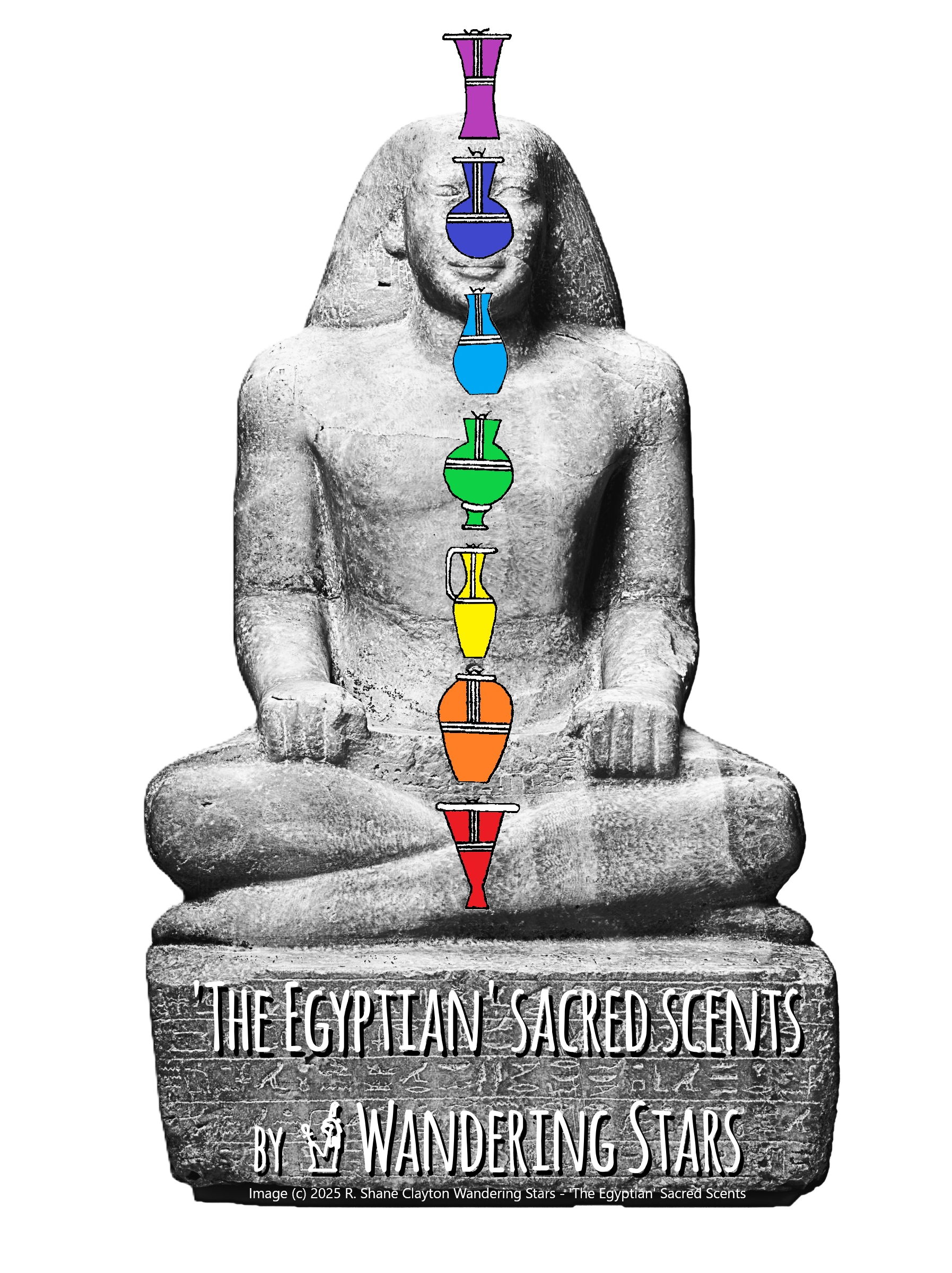The Seven Sacred Oils & The Chakras

1) Seti Heb — “Festival Scent”
2) Hekehenu — “Jubilation”
3) Sefet — “Fir”
4) Nekhenem — “Rejoining”
5) Tuat — “Support”
6) Hat en Ash — “Best Cedar”
7) Hat en Tjhenu — “Best Libyan
The oldest of these surviving jars, dated to pre-dynastic times, were found in tunnels and chambers deep under the Step Pyramid of Saqqara, many of them carved with bafflingly high precision from extremely hard stone — Pre-Dynastic Pharaonic heirlooms that were passed down for generations, some roughly inscribed with a later New Kingdom Pharoah's cartouche nearly two millennia after they were created.
Early sources state that the anointing of the deceased entailed “pouring” of the consecrated oils on the head and upon areas of the body corresponding to their “Seven Souls,” assumed to be based upon the seven-fold proportion standard of the Egyptian bas-relief carvings of the human form - a fascinating correspondence with the seven Chakras of Hinduism. These seven are incorporated and manifest in life together as the physical body, which dies, releasing two pairs: the Sah and Ba, the Shut and Ka.
7) The Akh — the magically effective spirit or body of light — Hat en Tjhenu oil
6) The Ka — the vital spark, the witness or inner genius — Hat en Ash oil
5) The Shut — the shadow — Tuat oil
4) The Ib (or Ab) — the heart, center of thought and emotions — Nekhenem oil
3) The Ba — the soul, will, or personality — Sefet oil
2) The Sah — the spiritual or dreaming body — Hekhenu oil
1) The Khat (or Khet) — the earthly physical body — Seti Heb oil
Those familiar with the seven Chakras and their associated perfumes in the Hindu religion may wish to compare the two systems along with the Egyptian 3 x 7 proportional guidelines for the human form in temple and tomb art. The Hebrew divisions of the soul, which can range from 3 to 7, are also worth comparison. These similar divisions and proportions deserve a separate article of their own.
More on the Akh from Wikipedia:
“The akh or ꜣḫ " (magically) effective one,” was a concept of the dead that varied over the long history of ancient Egyptian belief. Relative to the afterlife, the akh represented the deceased, who was transfigured and often identified with light.
It was associated with thought, but not as an action of the mind; rather, it was intellect as a living entity. The akh — ꜣḫ also played a role in the afterlife. Following the death of the khat — ẖt (physical body), the ba — bꜣ and ka — kꜣ were reunited to reanimate the akh ꜣḫ. The reanimation of the akh ꜣḫ was only possible if the proper funeral rites were executed and followed by constant offerings. The ritual was termed sa-akh, s-ꜣḫ "make (a dead person) into an (living) akh ꜣḫ.”
In her “Akh — A Religious Concept in Pharaonic Egypt “ (1978)
the Egyptologist Gertrud Englund summarizes the Akh as:
“the effective one... a glorious and shining spirit which has risen up to the heavenly realm to enjoy the eternal life... the consciousness or immaterial part of the person after the transfiguration of the Ba.”
The Egyptologists Jan Assmann and Massimiliano Nuzzolo tell us that “the ceremony was principally directed to effecting a spiritual transformation and interchange between two of the main immaterial forms of all human beings (including gods and pharaohs), the Ba and the Akh. This passage could be realized only if the living being, either reborn (the mummy) or created for the first time (the statue), would have harbored the divine spirit or vital spark of the Universe, the so-called Ka. The latter, joining the Ba, i.e. the soul, allowed the rebirth of the person in the afterlife and the reaching of the state of the perfect spirit — the Akh.”
(per Jan Assmann — “The Search For God in Ancient Egypt,” 2001, Massimiliano Nuzzolo — “Man Approaching God,” 2013).
See: The Seven Sacred Oils